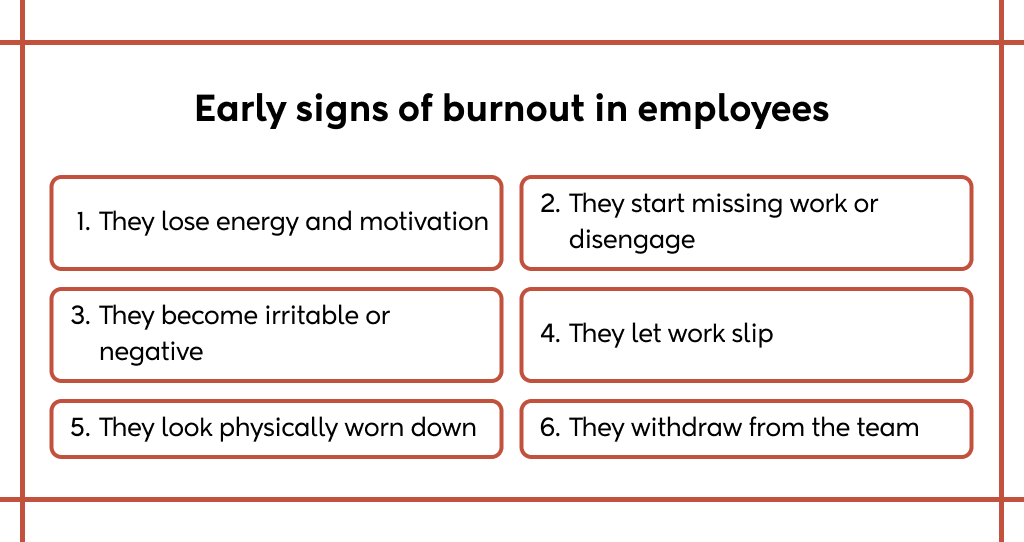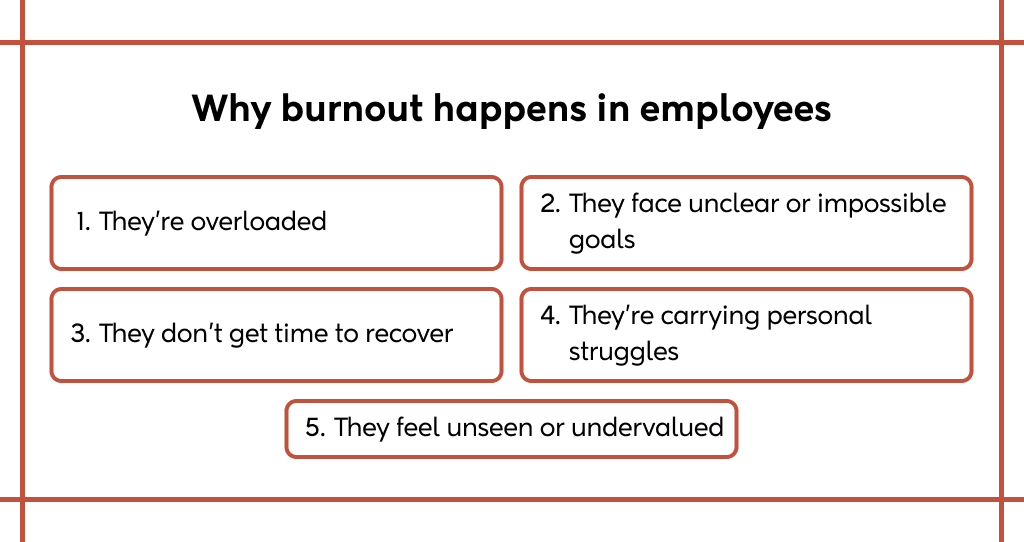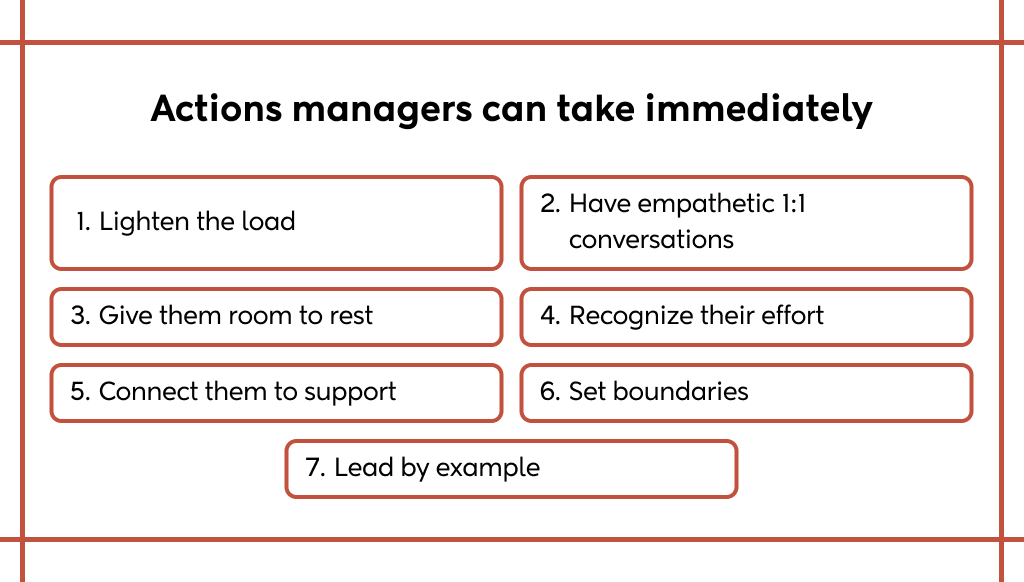If you’re a manager, you’ve probably seen it happen: a reliable employee suddenly starts slipping. They look drained, miss deadlines, or are disengaged in meetings. At first, it’s tempting to assume they’ve lost interest or motivation.
But the truth is often different – these are early signs of burnout. And if caught early, burnout doesn’t have to spiral into absenteeism, poor performance, or turnover.
Managers play a critical role here. You’re in the best position to notice the subtle changes, have the right conversations, and take action before things get worse.
This article will walk you through the early signs of burnout to watch for and the steps you can take immediately to protect your team’s well-being and keep performance high.
Early signs of burnout managers should look for
Burnout doesn’t happen overnight. It shows up in small but noticeable shifts in how employees think, act, and engage at work.

Here are some early signs of burnout that you can look for:
- They lose energy and motivation: A once-enthusiastic employee now seems drained. Tasks take longer, their input in meetings shrinks, and they look like they’re just going through the motions. This isn’t laziness, but often a sign of mental or physical exhaustion.
- They start missing work or disengage: Absences become more frequent, they arrive late or leave early, or they show up but aren’t really present. In a remote work environment, cameras stay off, participation is minimal, and messages go unanswered.
Also read: Revealed! The Happy Secret to Better Work
- They become irritable or negative: Stress can turn even steady employees short-tempered. They may complain more, show frustration over small issues, or become cynical about leadership and goals. A sudden shift in tone is often burnout speaking.
- They let work slip: Deadlines are missed, errors increase, and creativity drops. Someone who once brought fresh ideas may now stick to the bare minimum, struggling to focus or deliver their best.
- They look physically worn down: Constant fatigue, headaches, or frequent illnesses signal that stress is taking a toll. When health complaints pile up, it’s often burnout showing up in the body.
- They withdraw from the team: They stop volunteering, avoid collaboration, and pull back from colleagues. Conversations get shorter, and they prefer working alone, even if teamwork was once their strength.
Why burnout happens
Burnout is not about being weak or lazy. It happens when stress piles up and people don’t have enough resources, such as time, support, or energy to cope.

Here are a few reasons why burnout happens:
- They’re overloaded: Too many projects, long hours, and unrealistic deadlines wear people down. When there’s always more to do and no relief in sight, energy levels crash.
- They face unclear or impossible goals: Constantly shifting priorities, vague instructions, or targets that seem unachievable create frustration. Employees stop trying when they feel their effort won’t make a difference.
- They don’t get time to recover: Skipped breaks, late-night emails, and pressure to always be “available” prevent people from getting rest. Without downtime, work stress continues to build until it turns into exhaustion.
- They’re carrying personal struggles: A divorce, the loss of a loved one, health challenges, or family responsibilities can weigh heavily, even if they don’t talk about it at work. Most employees won’t share these openly unless they deeply trust their manager, which means signs may surface indirectly through performance or mood changes.
- They feel unseen or undervalued: Recognition is not just a “nice to have.” When people give their best and it goes unnoticed, motivation fades. Over time, lack of appreciation can be just as draining as a heavy workload.
Burnout is a stress response, not a personality flaw. It happens when demands exceed someone’s ability to cope, whether those demands come from the office, their personal life, or both.
Actions managers can take immediately

Spotting burnout is only half the job. What matters most is how you respond. Here are some actions that you can take when you notice the early signs:
- Lighten the load
A heavy workload is one of the fastest routes to burnout. If someone is carrying more than they can handle, step in quickly. Review their tasks, cut low-priority work, redistribute responsibilities, or extend deadlines.
Even temporary relief like pairing them with a teammate or removing nonessential admin tasks shows them they don’t have to silently push through. It signals that workload issues are a team problem, not an individual weakness.
- Have empathetic 1:1 conversations
Don’t jump straight into performance feedback. Instead, have a private 1:1 conversation where the focus is on them as a person. Ask open-ended questions like, “How’s your workload feeling?” or “Is there anything making your job harder right now?” Then listen without interrupting or judging.
Sometimes, just being heard reduces pressure. Active listening, validation, and empathy build trust and create space for employees to share what they may not volunteer in group settings.
- Give them room to rest
Burned-out employees often feel guilty about taking breaks or time off. As a manager, you can normalize rest. Encourage short breaks during the day, insist they use vacation days, and remind them to log off on time.
Offer flexibility if needed (like adjusted hours or occasional remote work) to help them recharge. Model this behavior yourself. If you’re sending midnight emails, they’ll be pressured to stay “on.” But if you prioritize work-life balance, they’ll see it’s safe for them too.
Also read: Strategies for Maintaining Work-Life Balance in the Workplace
- Recognize their effort
Burnout isn’t only about overwork, it’s also about being unseen. A lack of recognition leaves people wondering if their hard work matters. As a manager, you can counter this by showing appreciation often and specifically.
Call out achievements in team meetings, send a personal thank-you note, or highlight small wins with company-wide announcements. When employees know their contributions are valued, they are more motivated and less drained. Recognition is a simple act with a huge impact.
- Connect them to support
Sometimes burnout requires more than managerial support. Make sure your team knows what resources are available, such as employee assistance programs, mental health counseling, wellness workshops, or stress-management tools. Share these without stigma and frame them as signs of strength, not weakness.
Even if your company doesn’t have formal programs, you can share useful apps, articles, or webinars. What matters is showing employees they don’t have to face challenges alone.
- Set boundaries
Employees can’t recover if they’re always “on.” Protect them from unrealistic expectations by setting achievable timelines, clarifying top priorities, and pushing back against unnecessary urgency. Make it clear that you don’t expect late-night replies or weekend availability.
Respect their personal time and yours too. When boundaries are clear, employees can fully disconnect outside work and come back with more focus and energy.
- Lead by example
Team members mirror their managers. If you work nonstop, skip breaks, and never unplug, your team will assume that’s the standard.
Instead, model healthy behaviors. Take breaks, use your vacation days, and show that you value balance as much as performance. When managers demonstrate sustainable work habits, it gives employees permission to do the same.
Conclusion
As a manager, it’s easy to see burnout as an individual issue, but it’s not. When one employee struggles, the whole team feels the impact. Morale dips, projects slow down, and in time, good people leave.
However, burnout doesn’t arrive overnight, and you can identify it early. By paying attention to the small changes, such as low energy, withdrawal & irritability, and stepping in with empathy and action, you can prevent bigger problems down the line.
Everyone benefits when managers take burnout seriously: employees are supported, teams stay stronger, and in the end, the quality of work improves.




























No Comments